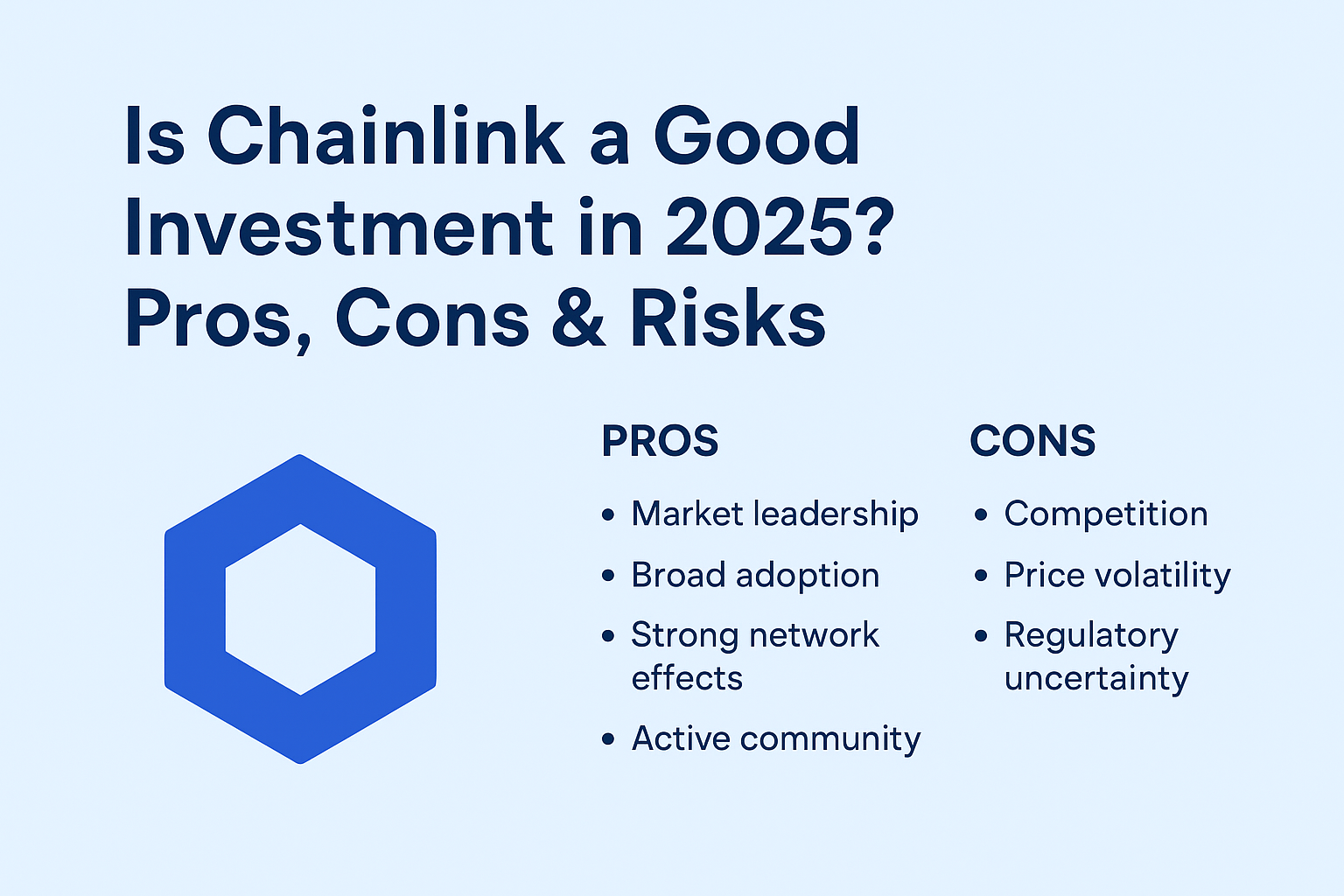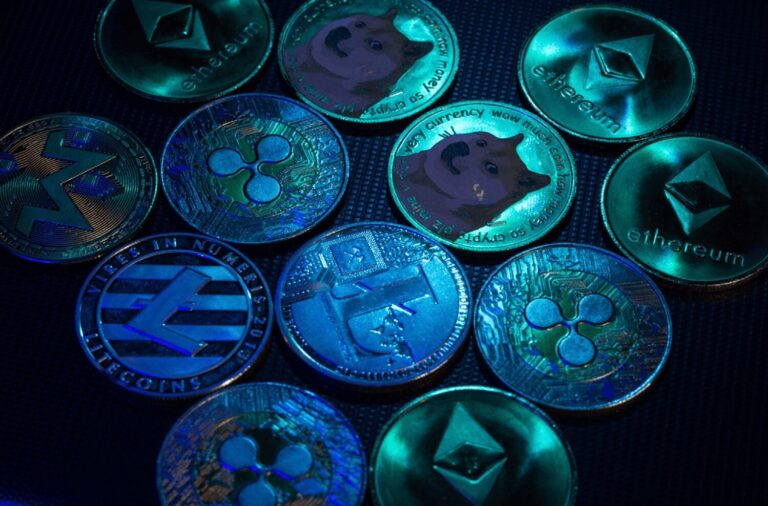
Chainlink
Introduction
Chainlink (LINK) has been one of the most discussed and widely integrated projects in the blockchain space since its launch in 2017. Acting as a decentralized oracle network, Chainlink plays a crucial role in enabling smart contracts to securely interact with real-world data — a function that underpins much of the decentralized finance (DeFi) ecosystem.
In 2025, LINK continues to be among the top cryptocurrencies by market capitalization and boasts a large, engaged community known as the “Chainlink Marines.” But with thousands of crypto projects in existence, is Chainlink still a good investment? Let’s break down its strengths, weaknesses, and risks so you can make an informed decision.
Understanding Chainlink
Before we discuss its investment potential, it’s important to understand what Chainlink is and why it exists.
-
Purpose: Chainlink is a decentralized network of oracles that feed real-world data into blockchains.
-
Problem It Solves: Blockchains are closed systems — they can’t natively access off-chain data like stock prices, weather conditions, or API data. Oracles solve this problem.
-
Why Decentralization Matters: Centralized oracles create a single point of failure. Chainlink’s decentralized approach reduces manipulation and downtime risks.
Chainlink’s technology powers key DeFi protocols like Aave, Synthetix, and Compound. It’s also integrated into NFT projects, insurance platforms, and supply chain systems.
Chainlink in 2025 — Current State
In 2025, Chainlink has evolved far beyond its initial scope:
-
CCIP (Cross-Chain Interoperability Protocol): Allows seamless data and token transfers across multiple blockchains.
-
Wider Adoption: Chainlink is used by both crypto-native projects and traditional enterprises.
-
Ecosystem Growth: More than 1,000 projects integrate Chainlink data feeds.
-
Staking Expansion: LINK staking now rewards node operators and community members, improving network security and incentivizing token holding.
Pros of Investing in Chainlink
a) Dominance in the Oracle Market
Chainlink remains the leading decentralized oracle provider. While there are competitors like Band Protocol, API3, and DIA, none match Chainlink’s market share, integrations, and reputation.
b) Strong Network Effects
The more projects that use Chainlink, the harder it becomes for competitors to displace it. This “stickiness” makes adoption growth self-reinforcing.
c) Real-World Adoption
Chainlink’s partnerships extend beyond DeFi into traditional finance, insurance, gaming, and supply chain management. Its CCIP could make it a critical player in cross-chain communication.
d) Active Development
The Chainlink team consistently ships new features — such as Proof of Reserve feeds, VRF (Verifiable Random Function) for gaming and NFTs, and automation tools for smart contracts.
e) Large and Engaged Community
The “Chainlink Marines” are highly active in promoting and defending the project online, which helps sustain awareness and engagement.
Cons of Investing in Chainlink
a) Dependence on Ethereum and DeFi
While Chainlink is blockchain-agnostic, much of its early adoption came from Ethereum-based DeFi projects. Any slowdown in DeFi growth could impact demand.
b) Slow Revenue Capture
Despite powering billions in transactions, the LINK token value doesn’t always directly correlate to usage. Monetization relies heavily on staking and token utility, which may not grow in sync with adoption.
c) Competition Risk
While Chainlink leads the oracle market, competitors can innovate faster or offer cheaper solutions. In crypto, disruption can be sudden.
d) Price Volatility
Like most cryptocurrencies, LINK experiences sharp price swings. Even with strong fundamentals, market sentiment can cause significant short-term losses.
Risks to Consider
a) Regulatory Risk
If regulators impose restrictions on crypto tokens or DeFi services, Chainlink integrations could face legal uncertainty — especially for enterprise use cases.
b) Technological Risk
If a major bug, exploit, or hack impacts Chainlink or its oracles, trust in the network could be severely damaged.
c) Tokenomics Uncertainty
While staking adds value, the impact on token supply and demand remains uncertain. Inflationary rewards could dilute value if not balanced by increased adoption.
d) Overreliance on a Single Narrative
If Chainlink’s role as the leading oracle provider is challenged, or if oracle demand slows, the core investment thesis could weaken.
Chainlink’s Price History & Market Cycles
-
2017–2019: LINK traded under $1 for years before the DeFi boom.
-
2020–2021 Bull Run: LINK reached an all-time high near $52 in May 2021, fueled by DeFi growth.
-
2022–2023 Bear Market: Price dropped below $6, reflecting broader crypto sentiment.
-
2024–2025 Recovery: LINK rebounded as CCIP adoption grew, and staking incentives attracted more holders.
Price history shows LINK is highly cyclical — long-term investors need patience and the ability to weather drawdowns.
Investment Strategies for LINK
If you decide to invest in Chainlink, consider these approaches:
-
Dollar-Cost Averaging (DCA): Spread purchases over time to reduce the impact of volatility.
-
Stake LINK: Earn rewards and contribute to network security.
-
Long-Term Hold: Given Chainlink’s infrastructure role, long-term holding may benefit from network growth.
-
Portfolio Diversification: Avoid putting all your funds into LINK; balance with other assets.
Final Verdict — Is Chainlink a Good Investment in 2025?
Chainlink has established itself as a critical infrastructure layer for Web3 and is likely to remain relevant in the years ahead. Its dominance in the decentralized oracle sector, expanding ecosystem, and strong developer activity make it a compelling project for those who believe in the long-term growth of blockchain technology.
However, as with all crypto assets, risks are significant. Market volatility, competition, and regulatory shifts can impact performance. Investors should treat LINK as a high-risk, high-reward asset and size positions accordingly.
Key Takeaways
-
Strengths: Market leader in decentralized oracles, strong partnerships, real-world adoption, active development.
-
Weaknesses: Price volatility, slow monetization, heavy reliance on DeFi growth.
-
Risks: Regulatory, competitive, technological vulnerabilities.
-
Outlook: Positive for long-term believers in blockchain infrastructure, but not without substantial risk.


